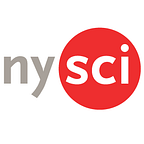STEM Profiles: “Sometimes we need to force ourselves to sketch it out”
NYSCI is running a series we call STEM Profiles. They’re pieces by, or about, people who are working in scientific and technical fields, bringing a broader definition to what it means to practice science, technology, engineering and math.
Our newest profile is of Keith Appleby, an architect and design associate at Svigals + Partners in New Haven, Connecticut. Svigals + Partners is at the intersection of art and STEM (or STEAM), designing buildings and structures that are visually appealing, while using the principals of math and engineering to make sure those same designs stay upright.
He has some things in common with Ayah Bdeir, who we profiled at the start of the series a couple weeks ago. Keith’s work is what happens when seemingly disparate disciplines, like engineering and design, come together — the resulting work products are vital, important and inspiring.
Suppose you’re a college student deeply into the STEM subjects but also fascinated by art. What major should you choose? For Keith Appleby, the obvious answer was architecture.
Appleby, a 27-year-old design associate at Svigals + Partners, a New Haven, Connecticut-based firm that designed the new Sandy Hook Elementary School in Newtown, felt that architecture would offer the perfect overlap “between the creative brain and the analytical brain.” Appleby’s education prepared him for the realities of a modern design career — a profession that is now far removed from the drafting tables of the past and wedded to collaborative computer programs.
He earned his degree as part of a five-year program at Carnegie Mellon’s School of Architecture (class of 2012). The program was rigorous, with required courses in calculus, structural and mechanical engineering, and a first year that Appleby suspects was designed to “put students through the ringer.”
He laid the foundation for this work during high school, when in addition to taking art classes each year — a rarity at his intense prep school — he also sought out summer courses in engineering and genetics at Johns Hopkins. Carnegie Mellon also offered its architecture students courses in cutting-edge computer programs and renowned courses in sustainable design.
Appleby praises the program’s curriculum for not creating “pigeon-holed CAD monkeys.” He says, “They knew that most people are not getting into the profession to be technical architects,” adding, “It’s clear when I think back that the education was really pushing us in these different STEM directions to make sure we would be ready for the future.”
And the future is tech.
His typical workday involves drafting and producing building plans — all on the computer, often for nine hours or more. “Drafting for us is sitting at a computer and producing in the program, and instead of drawing these sketches, we’re building a three dimensional model that contains a lot of information. We are still doing some drafting on the computer, but it’s gotten more and more complex.”
Drafting on the computers allows for greater collaboration, sometimes connecting offices around the world, as well as greater precision in design. For instance, architects and engineers draft separate 3D designs with layouts of each of the building’s systems. This allows for a process called “clash detection” in which the teams overlay the models to discover if, say, a toilet drainpipe is running through a staircase.
Computer-generated drafting allows for a level of coordination not seen before the advent of CAD.
This brave new world designing with technology has changed the way architects apply their STEM knowledge. Math is certainly still used, though his mandatory college Calculus course is not knowledge he uses regularly. It is much more important that he be able to do “loose calculations.” As for engineering, though Appleby took several courses in college, in the true world of professional architecture they often hire out for engineers. This disparity between his course work and his career does not bother him. “As an architect,” he says, “you want to know a little about everything, whereas the engineer wants to know a lot about one thing or a couple things.”
Besides, his true passion remains an artistic one. He calls the creative side of architecture his “natural inclination,” explaining, “I took engineering, I took genetics courses, these various influences in science — always being interested in it, but I just never found the same propensity for success as I did in the artistic field.”
Appleby still does a fair amount of sketching by hand. Calling it his “primary interest,” he notes that it gives him a unique advantage over those who are less comfortable sketching, and speaks of the “unique” and “symbiotic” connection between the hand and the brain. “You’re not going to be hired nowadays unless you can draft on a computer. But, sometimes we need to force ourselves to sketch it out and see what our brain is really thinking.”
